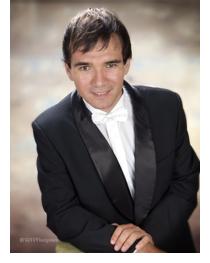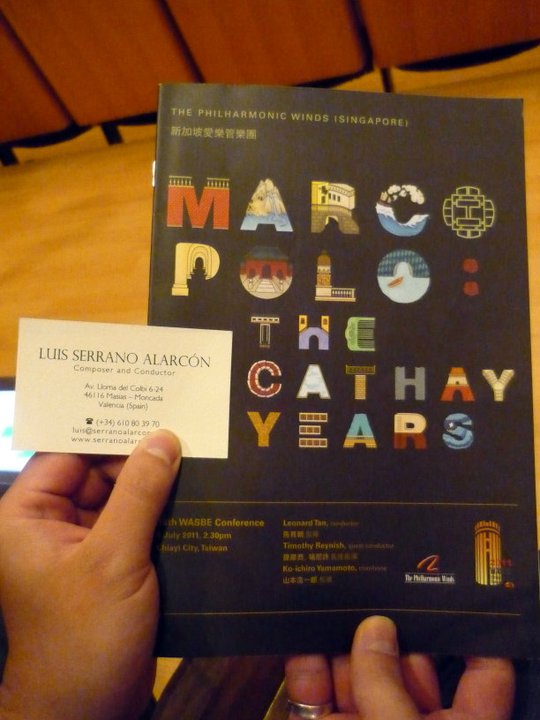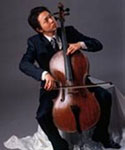LUIS SERRANO ALARCON
(Born Valencia, 30th July 1972)
Website www.serranoalarcon.com
Tim Reynish Revised March 2012

Although he is basically self-taught as a composer, Luis Serrano Alarcón feels a deep gratitude to some teachers who had a decisive influence on his formation. Jose Mª Cervera Lloret, Jose Mª Cervera Collado, Javier Barranco and the musical society “ La Artística ” from Chiva, where he started with his first musical lessons.
Nowadays Luis Serrano Alarcón is one of the most outstanding Spanish composers. His works have been performed in over 25 countries, has been invited to conduct his own music in Spain, Italy, Singapore, USA and Colombia and has received commissions from major organizations and groups like the International Band Competition Villa Altea International Band Competition in Valencia, Saint Thomas University (Minnesota, USA) and The Philharmonic Winds (Singapore) among others.
In 2006 he won the first award at the International Band Competition Contest of Corciano, Italy with the piece Preludio y Danza del Alba, for brass quintet and Symphonic Band, repeating the same award in 2009 with his piece La Dama Centinela making him the only composer that has won this prestigious award in two occasions.
Besides composing, Luis Serrano Alarcon teaches Analysis and Composition at the Professional Conservatory of Valencia, and in November 2006 he was appointed principal conductor of the Symphonic Band “Centre Artístic Musical” from Betera (Valencia). With this band he performed in Cincinnati, United States, during the WASBE Conference, in July 2009.
I wrote:

While much of the original repertoire of Spanish music is essentially intended as pure entertainment, I suspect that there are a number of composers who transform the rhythms and idioms of the traditional dances and songs into "art" music. One such is certainly Luis Serrano Alarcón. Thirty nine years old, and already established as one of the top wind band composers of the world, Luis Serrano Alarcon has earlier this year completed a new work, Marco Polo, the Cathay Years, which was premiered by Philharmonic Winds, Singapore at the WASBE Conference in Taiwan and in Singapore a few days earlier, the second part of a massive three part trilogy on the exploits of Marco Polo.
A CD of his music, played by Union Musical Utielana conducted by Frank de Vuyst, gives an overview of three major works Concertango, the opening work, gives the CD its title; this is a twenty five minute, three movement concerto for Alto Saxophone, Jazz Trio and Band. Inspired by the music of Piazzolla, the spirit of the Tango is omnipresent, but there are sections which are jazz inspired and wonderfully lazy Mediterranean reflective passages. I fell in love with Concertango some years ago, and have conducted it in many countries including Australia, Netherlands, Singapore, UK, USA, and Venezuela, always with a huge success. It is a wonderful tribute to the spirit of the tango and of Piazzolla. I would recommend this to any band playing Grade 4/5 literature, whether school, college or professional; I have conducted this very successfully on numerous occasions with both players and audience enjoying it thoroughly.
Concertango Part 1 played by Philharmonic Winds
Concertango Part 2 played by Philharmonic Winds
In the programme notes, the composer writes
Concertango is first of all a work of fusion. On the one hand there is instrumental fusion, combining a classical symphonic group with a jazz trio (piano, bass, drums). Above these two groups, the saxophone soloist is the absolute protagonist. On the other hand, there is stylistic fusion. We can find in this piece different stylistic reminiscences, from symphonic music from the beginning of the 20th century, till real jazz elements. And above all, the tango is always present, specially the person of Astor Piazzola. The title, a clear reference to one of Piazzola’s most famous pieces, such as Libertango or Violentango, makes that very clear from the very beginning that Piazzola was the real inspirer of this piece.
Two other works on this disc, Memorias de un Hombre de Ciudad or Memoirs of a City Man, and De Tiempo y Quimera, are both major pieces.
Memorias de un hombre de ciudad 1-3
Memorias de un hombre de ciudad 4-5
Memorias de un hombre de ciudad 6-7
In 2010, Luis conducted the Philharmonic Winds in a concert devoted to his music which included his Tramonto for cello and wind orchestra, played by world famous cellist Li-Wei Qin
But it is Marco Polo; la ruta de la seda which for me was a revelation, combining the full Spanish wind band with cellos and basses, with a series of ethnic woodwind and percussion which help to paint the picture of the voyages. Luis was at the WASBE Conference with the Philharmonic Winds who premiered his Marco Polo; the Cathay Years, a magnificent symphonic tone poem employing Chinese instruments and choir, though if you have neither there are cues for the wind orchestra. The reviewer in the Singapore Straits Times wrote of the premiere:
The title of this concert refers to the second part of an on-going wind orchestra trilogy by Spanish composer Luis Serrano Alarcon. Commissioned by The Philharmonic Winds, the 20-minute work received its World Premiere conducted by America-based Singaporean conductor Leonard Tan. Written in the form of a four-movement symphony, it was more like a huge concerto grosso graced by a sextet of Chinese instruments from the Ding Yi Music Company as soloists.
The Oriental feel in the music was immediately palpable, skilfully enacted by a master colourist and orchestrator. This was achieved without quoting actual Chinese melodies, but by the deft use of the pentatonic scale and modes, much like the atmospheric scenes created in Turandot by Puccini. The exoticism, ceremonial rites and visions of the Far East came through so winningly that one almost forgot that Marco Polo and the composer were in fact Mediterranean in origin.
I found Marco Polo entrancing, as fascinating on the 5th hearing as the first, a big romantic score in which the orchestra sings if there is no choir, and can play cues if you have no access to dizi, qdi, suona or erhu, a ravishing tone poem with a strong story.
For me this was an absolutely outstanding piece,
For me this was one of the outstanding works at WASBE, and I would warmly recommend you to listen on YouTube
Marco Polo; the Cathay Years Movements 1 & 2 by Luis Serrano Alarcon
Marco Polo; the Cathay Years Movements 3 & 4 by Luis Serrano Alaracon
There is a further performance recently uploaded, conducted by Luis with his wonderful Centre Artístic Musical de Bétera
Centre Artístic Musical de Bétera plays Marco Polo; The Cathay Years Movements 1 & 2
Centre Artístic Musical de Bétera plays Marco Polo; The Cathay Years Movements 3 & 4
Also recently uploaded on YouTube is a superb performance of
Duende played by the Centro Instructivo Musical la Armónica de Buñol, director Frank De Vuyst
I am uploading links to a performance of the Little Suite, with Philharmonic Winds conducted by Luis, a more practical proposition. Like all his music, it is published by Piles and is for me a major addition to the repertoire of delightful pieces which are both amusing and beautiful
The Pequena Suite, literally the Little Suite is in four movements, each strongly contrasted. In the Intrata, An imposing fanfare introduces the suite but it gives way to a rather menacing little march with an unexpected flip ending. Movement two is the most charming Waltz, light music at its best, ranging through the most unexpected keys, clearly paying a little homage to Ravel’s La Valse, and again ending superbly. Nana can mean either a lullaby, a grandmother or a nurse; Alarcon has the knack like Adam Gorb of writing wonderful tunes, sometimes just on the edge of descending into a cliché but rarely doing so, and here he writes a glorious tune for the first oboe. The fourth movement is just a piece of sheer fun, a gallop which might remind conductors and players of those hair-raising finales by members of Les Six, outrageous jokes piling on top of one another.
Pequena Suite para Banda by Luis Serrano Alarcon (1. Intrata)
Pequena Suite para Banda by Luis Serrano Alarcon (2. Vals)
Pequena Suite para Banda by Luis Serrano Alarcon (3. Nana)
Pequena Suite para Banda by Luis Serrano Alarcon (4. Galop)
I have no doubt that Luis is one of the most important composers working in the medium of wind orchestra of today.
Luis Serrano Alarcón luis@serranoalarcon.com
- Contacto Editorial
- Piles, Editorial de Música. Valencia. España.
- info@pilesmusic.net
- Tel: +34 963 704 027
- Frank De Vuyst
- (Responsable del Departamento de Banda y Relaciones Públicas Internacionales)
- frank@pilesmusic.net
